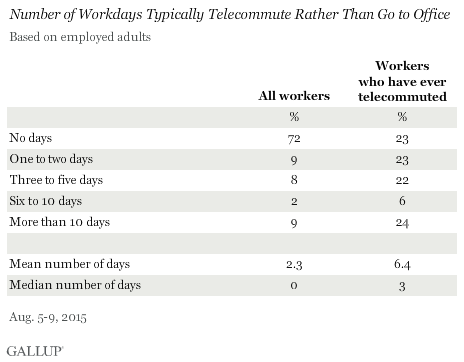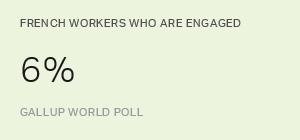Story Highlights
- Average worker telecommutes two days per month
- 46% of telecommuters do so during the workday
- Most say telecommuters just as productive as other employees
PRINCETON, N.J. -- Thirty-seven percent of U.S. workers say they have telecommuted, up slightly from 30% last decade but four times greater than the 9% found in 1995.

These results are based on Gallup's annual Work and Education poll, conducted Aug. 5-9. Technology has made telecommuting easier for workers, and most companies seem willing to let workers do their work remotely, at least on an occasional basis if the position allows for it. Even though telecommuting has become more common, the growth in the practice appears to have leveled off in recent years. It is unclear how much more prevalent telecommuting can become because it is really only feasible for workers who primarily work in offices using a computer to perform most of their work duties.
Along these lines, telecommuting is much more common among those who have had more formal education, those who are upper-income and those who have white-collar professions.

While a greater percentage of U.S. workers now say they have telecommuted than in the past, telecommuting remains much more the exception than the rule. U.S. workers say they telecommute from home rather than go into the office about two days per month, on average. Nine percent of workers say they telecommute more than 10 workdays -- meaning at least half of all workdays -- in a typical month.

Among the smaller group of workers who say they have ever telecommuted, the average number of remote workdays is 6.4, and 24% of this group telecommutes more than 10 workdays in a typical month.
The average number of workdays that workers telecommute has not changed much since 2006.
More Telecommuters Foregoing the Office
Telecommuting can take either of two forms. One, perhaps the way people typically think of telecommuting, is an employee working from his or her home office or a coffee shop during normal working hours instead of going into the office. But workers can also telecommute in addition to being in the office by logging on from home during evenings or weekends, when necessary.
In the past, more telecommuters said they most often telecommuted outside of working hours in addition to going into the office during the day. But now they are as likely to say they telecommute during the workday instead of going to the office. This represents a significant shift in the nature of telecommuting, from its use as a supplement to the normal workday to its use as a replacement for being in the office.

Americans Say Telecommuters Just as Productive as Other Workers
Since telecommuting became a reality for many U.S. workers, there has been ongoing debate about whether it is more beneficial or more detrimental to worker productivity. The majority of Americans, including both those employed and not employed, believe workers who work remotely are just as productive as those who work in a business office. The 58% holding this view is up from 47% the first time Gallup asked the question in 1995. This is offset by a drop in the percentage believing telecommuters are more productive than those who work in an office, from 28% to 16%. The net result is a similar proportion believing telecommuters are at least as effective as those who work in offices, given that the 20% who say telecommuters are less productive is essentially unchanged since 1995.

Telecommuters' opinions are generally similar to those of all Americans. Fifty-six percent believe those who work remotely are just as productive as those who work in offices, while 24% say telecommuters are more productive and 18% say they are less productive.
Implications
Tech giant Yahoo made news in 2013 when CEO Marissa Mayer changed company policy to require all workers to work in a corporate office. Yahoo's policy aside, an increasing number of employers allow workers the flexibility to do their job remotely if it is feasible for their position. More American workers, though still a minority, now say they have telecommuted than said so in three prior Gallup surveys. However, the growth of the practice appears to be slowing.
Moreover, those who telecommute do not do so on a very frequent basis, averaging six days per month with only about one in four telecommuters -- the equivalent of one in 11 employed Americans -- working remotely from home instead of going to the office on most workdays.
While most assume telecommuting is beneficial to employees, the question remains whether it is beneficial to employers. In one respect, employers might use their telecommuting policy as a way to retain talented workers who may otherwise need to change jobs or stop working altogether. Gallup's workplace research shows that employees who spend at least some time working remotely are a bit more likely to be engaged in their jobs than those who never work remotely.
It is unclear from those relationships whether telecommuting increases engagement or workers who telecommute (and tend to be more highly educated, white-collar employees) are more likely to be engaged in their work in general. Regardless of the causality, Gallup research has consistently demonstrated that companies with a more engaged workforce tend to do better in a variety of business outcomes, including productivity, profitability and customer engagement.
Historical data for this question is available in Gallup Analytics.
Survey Methods
Results for this Gallup poll are based on telephone interviews conducted Aug. 5-9, 2015, with a random sample of 1,011 adults, aged 18 and older, living in all 50 U.S. states and the District of Columbia. For results based on the total sample of national adults, the margin of sampling error is ±4 percentage points at the 95% confidence level.
For results based on the total sample of 485 adults employed full or part time, the margin of sampling error is ±6 percentage points at the 95% confidence level.
For results based on the total sample of 209 workers who have telecommuted, the margin of sampling error is ±9 percentage points at the 95% confidence level.
All reported margins of sampling error include computed design effects for weighting.
Each sample of national adults includes a minimum quota of 50% cellphone respondents and 50% landline respondents, with additional minimum quotas by time zone within region. Landline and cellular telephone numbers are selected using random-digit-dial methods.
View complete question responses and trends.
Learn more about how the Gallup Poll Social Series works.
